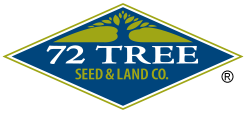Notice: Undefined variable: page in /home/vrxdg1855sn3/public_html/wp-content/themes/72tree/content.php on line 15
Notice: Trying to get property 'ID' of non-object in /home/vrxdg1855sn3/public_html/wp-content/themes/72tree/content.php on line 15
How To Get Rid of Tree Fungi
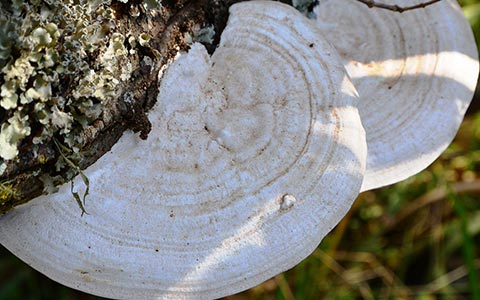
That fungus growing on your tree could kill it and turn it into an extreme hazard. By knowing how to deal with tree fungi, you can help your tree thrive for decades.
72tree.com gathered information on identifying harmful tree fungi, how to get rid of it, and what you can do to prevent it.
How To Treat Tree Fungus
Before you start dowsing your tree with fungicides and other chemical mixtures, you need to identify what type of fungus is growing on your tree and if it can be removed safely.
Mushroom Conks – If you have mushroom conks growing out of your tree trunk, it is a sign that the fungi at work have already penetrated the tree’s defenses and are decaying the heartwood of the tree.
For these mushroom conks to appear, there must be decaying wood within the tree to feed the fungus. This type of inner decay is known as heart rot.
When mushrooms grow from the root flare or in abundance on surface roots, you can be certain that the root system of the tree has been compromised and requires immediate attention.
Treatment: Do not try to remove mushroom conks from a tree, you may inadvertently release billions of spores that can infect surrounding trees and plants. Call a professional tree service to evaluate the extent of the damage to the tree and recommend a course of action.
Lichens – A lichen, or lichenized fungus, is two organisms functioning as one. Lichens comprise a fungus in a symbiotic relationship with an alga and typically appear as a flat rounded leafy structure attached to the bark of a tree.
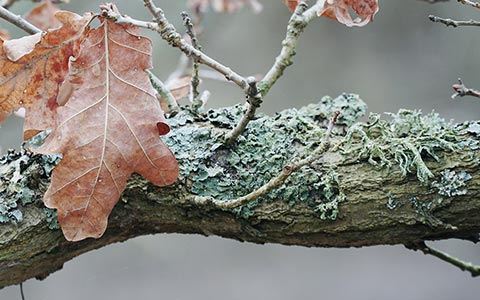
Lichens may appear harmful but are superficial, cosmetic eyesores at best. These organisms do not possess roots and rarely cause any damage to the organism they attach themselves to.
Treatment: If you wish, most lichen species can be eliminated from a tree with a mixture of 6 tablespoons of liquid copper sulfate mixed with 1 gallon of water applied during the tree’s dormant season. When applying this mixture, cover the lichen to the point of runoff.
Before using chemicals to control lichens, read the instructions printed on the label. By following the manufacturer’s recommended directions, you can increase the chemical’s effectiveness while preventing injury to the tree.
Fire Blight – Fire Blight can be caused by bacterial and/or fungal infections. It causes twigs and branches to appear water-soaked, then dark, and finally dry and cracked. Twigs and branches die from the terminal end and take on a burned appearance. Branches may bend or curl, commonly referred to as “shepherd’s crook.” As leaves and fruit die, they remain on the branches.
Treatment: Prune out infected branches (at least 8 inches below the damage) during the spring and summer. Do not prune while the branches are wet, as blight is highly transmissible via splashing water. Sterilize all pruning equipment before and after use on an infected tree.
Chemical control of blight is not always effective and should be used as a preventative measure in healthy trees.
Read more about fire blight prevention at 72tree.com/preventing-fire-blight-tree-disease/
Cankers – Cankers are dead, fungus-infected portions of tree bark on the branches or the trunk. They may appear as dark, open, seething wounds, or sunken, darkened, “wet” areas of bark. Most plant pathogens cannot penetrate tree bark directly. Still, they will colonize bark wounded by wildlife, poor maintenance, or mechanical injury.
Canker diseases can cause extensive damage to trees when they kill enough of the bark to girdle a branch or trunk. The fungus causing the canker is also capable of spreading throughout the tree, by way of the xylem and phloem, eventually appearing in other areas of the tree.
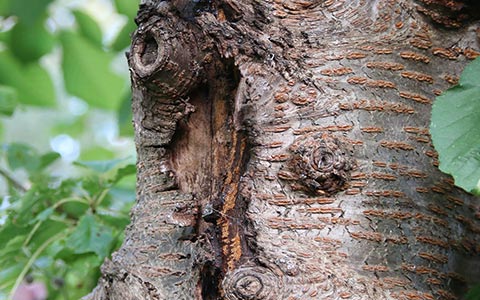
Treatment: For cankers found on twigs, and branches, prune the affected twig or branch from the tree. While normal pruning activities should be restricted to the tree’s dormant season, cankers are considered urgent. They can be pruned off the tree at any time of the year.
Note: Sterilize your pruning equipment before and after use on an infected tree. By doing so, you can prevent introducing another pathogen to the already sickened tree, and carrying the illness to another healthy tree.
For small cankers on tree trunks, tracing may help to reduce damage and slow its spread. Cut outside the cankered area into healthy bark, shaping the cut as an ellipse (this will allow the tree to compartmentalize the entire wound over time). Care should be taken to avoid infection of the fresh wound with canker or other pathogens.
For larger cankers on the trunk of a tree, call a professional tree service to evaluate the extent of the damage and recommend a course of action to either treat and save the tree or remove it.
Read more about heart rot and other diseases at 72tree.com/5-tree-pests-diseases-avoid-spring/
Tree Fungus Prevention
Trees have evolved over thousands of years to protect themselves against illness and infestations. They are highly efficient at protecting themselves when they are healthy and thriving. You can aide your tree by:
• Carefully apply fungicides during dry weather and before fungal growth
• Making sure pruning activities are done timely and with sterilized equipment
• Promoting its health throughout the growing season
• Using insecticides to prevent insect infestations
• Removing suckers from surface roots
• Preventing soil compaction on or around the root plate
• Immediately addressing storm damage
• Addressing or removing troubled trees from or around your property
Tip: You can help trees fight fungal attacks and heal themselves by promoting their health. These are some of the things you can do to improve the health of your tree:
• Seasonal Pruning
• Annual Tree Inspections
• Organic Mulch
• Deep Watering (without overwatering)
• Fertilization
• Protect Surface Roots and Trunk from Damage
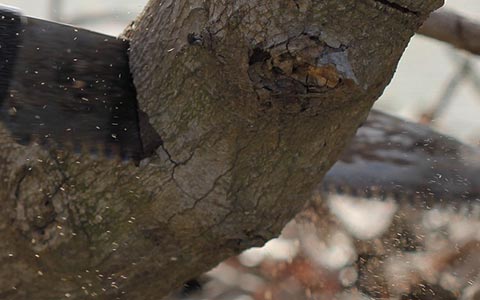
The importance of an annual tree inspection cannot be overstated. Detecting problems in their beginning stages helps you eliminate the existing problems and prevent potential issues throughout the growing season.
Killing Tree Fungus
In this article, you discovered the different fungi that can attack and harm your tree, how to treat it, and prevent it.
By taking swift action to remove fungus-infected parts of a tree and use measures to stop future infections, you are extending the life of your tree, and preventing it from becoming a threat to your property and wellbeing.
When you ignore the signs of fungal infections on your tree, you risk the tree dying and causing catastrophic damages when it eventually succumbs and falls.
Sources:
herbarium.usu.edu/fun-with-fungi/lichens
plantclinic.cornell.edu/factsheets/treecankers.pdf
vegcropshotline.org/article/10-useful-rules-for-fungicide-application/
extension.uga.edu/publications/detail.html?number=C871&title=Fireblight:%20Symptoms,%20Causes,%20and%20Treatment
